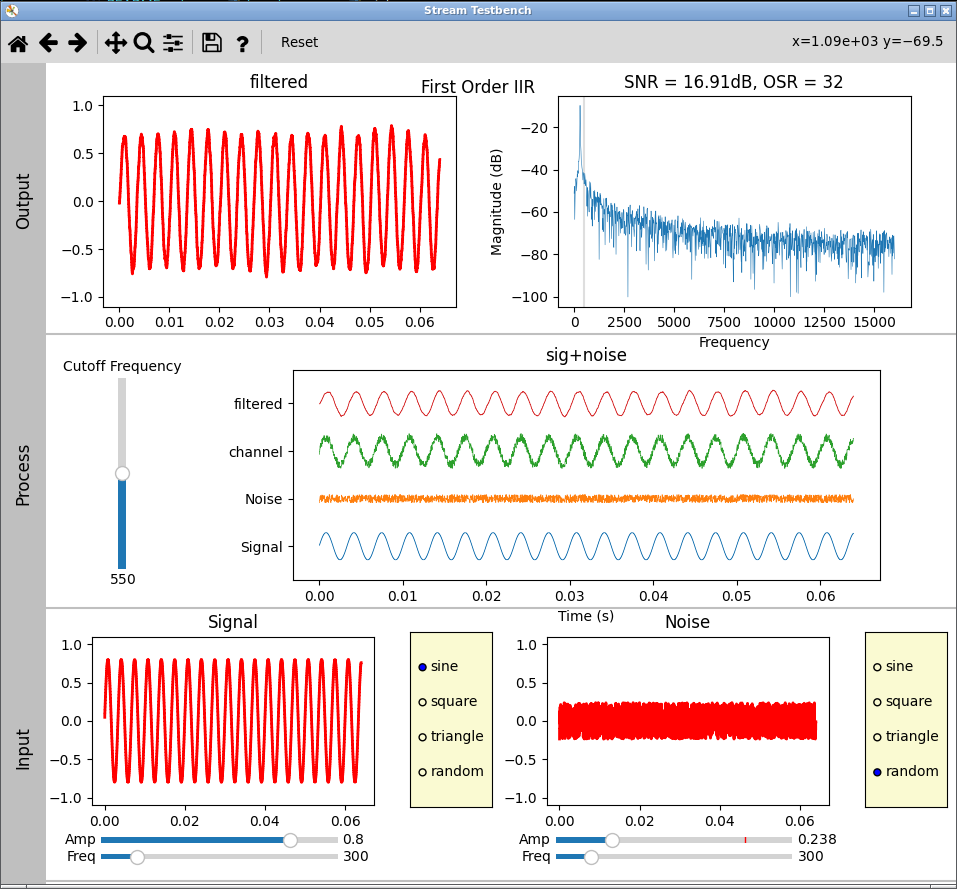A Python Test Bench for prototyping and visualizing stream-based Signal Processing Blocks.
While exploring some simple signal processing concepts on a small flash based 8bit microcontroller I found I was loosing momentum spinning in the burn-and-learn cycle. Derived from Harnesser's delta-sigma-py project, StreamTestBench attempts to isolate the signal processing block under investigation from both the testbench and the hardware so the developer can stay focused on the algorithm itself.
- function generator with sine, square, triangle, and random stream generation.
- spectrum analyzer for displaying a single stream.
- xy display for scope like visualization of a single stream.
- testpoints for multi-stream display with a shared time axis.
A Block is a single element in a signal processing chain that processes a stream of data. It is a container for the algorithms and code that the investigator is exploring. Inherit from it and add code necessary to explore the algorithm needed. The example blocks will give a good starting point.
- blocks/dsm.py Various Delta Sigma Modulators
- blocks/math.py Multiply, addition, and inversion
- blocks/filters.py Single pole IIR low pass filters
All blocks get their input from and send their output to streams. The Stream class contains a numpy time array, a sample array, and the metadata needed by the blocks for processing the stream data. In addition, the Stream class is derived from a Listener which handles the work of shuffling the streams between blocks using an event system, placing very few requirements on the prototype.
Both float and integer sample data types are currently supported. The integer type is included to help identify rollover and rollover prevention techniques when porting to C on small microcontrollers.
A Parameter is analogous to a single element stream. Parameters contain a single value that remains constant through the processing of a stream of samples. Corner frequency or filter coefficients would be good examples of parameters. Like the Stream class, Parameter is derived from a Listener and will alert its users to change. The filter.py example makes use of a slider parameter for setting corner frequency.
Altho installing isnt necessary, it allows a user's test-bench to be associated with their project rather than the clone.
- activate a venv
pip install matplotlibgit clone https://github.com/coburnw/StreamTestBench.gitcd StreamTestBenchpip install --editable .# note the trailing dot to indicate current directorypip uninstall StreamTestBench# to remove
Installing as editable make any changes to the repository, including git pull updates, take effect immediately.
All wiring and configuration of the testbench is done at the python level. Use the included example applications as a starting point.
A Reset Button is provided to reload the modulators.py module,
so a small bit of live-coding can happen without having to kill and
reload the Matplotlib window. Altho the reset button functions as
expected, the importlib.reload does not fit with the new structure.
This is a nice feature that needs to be reimplemented.
- fft and snr code is from the original dsm focused project. Blindly applying it to a generic stream as attempted here may not be wise.
- signal processing, or math for that matter, are not of my strong suits. The user would be remiss to think their results might represent reality without serious validation on their part.
- StreamTestBench is derived from delta-sigma-py without which I would still be downloading to flash and cursing with each slip of the scope probe.
- reimplement the reload button
- Investigate allowing stream meta change in gui
- Generalize spectrum analyzer and validate
- Plot a zoom-in of the baseband
- Calculate the SNR over the baseband
- Allow to store a previous FFT, and plot with the latest for easy comparisons
